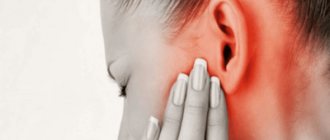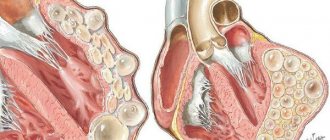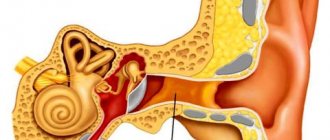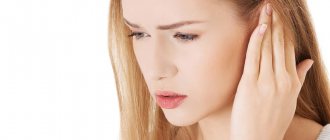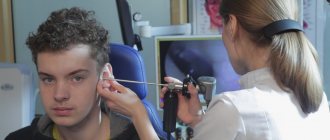- Symptoms of Meniere's disease
- Classification
- Causes of the disease
- Diagnostics
- Treatment of Meniere's disease Drug treatment.
- Surgery.
- Other methods of treating Meniere's disease Treatment of this disease should be carried out simultaneously with the correction of the patient's life and diet.
Meniere's disease is a disease that causes excess fluid to form in the inner ear. Since this department is responsible for spatial orientation and maintaining balance of the human body, dysfunction of the inner ear leads to the development of characteristic symptoms.
Symptoms of Meniere's disease
The most striking manifestation of the disease is systemic dizziness. It is this symptom that most often forces the patient to seek diagnosis and subsequent treatment for Meniere’s disease. During an attack of dizziness, a person experiences a sensation as if the entire space around him is in motion - the surrounding objects are shifting and rotating. Unlike ordinary dizziness, systemic dizziness causes a feeling that the body is “falling through”, tilting heavily. The sensations are so strong that the patient is unable to stand on his feet, and reflexively grabs furniture, people standing nearby and, in principle, cannot maintain an upright body position or even sit. The duration of the attack can last from several minutes to several days, but the average duration of an episode of systemic vertigo is 2-7 hours.
In addition to this symptom, Meniere's disease also manifests itself with other, less obvious, but requiring the attention of specialists:
- Reduced hearing acuity and hearing disorders. In this case, the patient periodically notes congestion in the affected ear and a decrease in the perception of low frequencies. As the disease progresses, the decrease in hearing acuity progresses with each new attack. Without treatment, Meniere's disease leads to complete and irreversible deafness.
- Nausea and vomiting. During attacks of systemic vertigo, these symptoms are very common and occur for the same reason as motion sickness. Subjective sensations of rotation of the space itself and one’s own body in it cause the patient to experience episodes of uncontrollable vomiting.
- During attacks of systemic dizziness, pale skin, abnormal heart rate, excessive sweating, and the patient’s inability to focus are noted (patients experience rotational movement of the eyeballs).
At the beginning of the development of the disease, exacerbation of the disease alternates with periods of remission, during which the patient is more or less able to restore working capacity. Treatment of Meniere's disease at this stage is most effective, as it helps prevent further dysfunction of the inner ear. But as the disease progresses, the severity of attacks of systemic dizziness increases, and the functions of the inner ear undergo increasingly negative changes. And during periods without exacerbations, the patient continues to suffer from heaviness in the head, noise and ringing in the ears, and impaired coordination of movements. If left untreated, Meniere's disease can lead to the spread of the pathological process to the healthy ear, which causes the development of complete deafness. And regular and increasingly intensifying episodes of dizziness can lead to the patient losing the ability to perform simple actions and having to constantly stay at home.
Symptoms
The signs are as follows:
- The presence of attacks, and between them there are no symptoms (except for the fact that the patient has difficulty hearing).
- Slow decrease in hearing (at the same time, a sharp improvement may be observed).
- Dizziness (usually occurs suddenly).
- Presence of tinnitus.
When the disease is advanced, signs such as vomiting, nausea, pale complexion, increased sweating, low temperature, and lack of balance are observed. All these symptoms intensify during movement.
Classification
Meniere's disease is usually classified according to the symptoms that predominate at the onset of the disease:
- Cochlear form. It is observed in approximately half of all cases of the disease. The cochlear form is characterized by the onset of the disease, in which the patient experiences predominantly auditory disturbances (noise and ringing in the ears, decreased hearing acuity).
- Vestibular form. It is diagnosed in about 20% of all cases of Meniere's disease. The disease begins with more or less pronounced vestibular disorders and episodes of systemic dizziness.
- Classic (or mixed) form. In this form of the disease, cochlear and vestibular symptoms arise and develop simultaneously. The severity of the hearing loss and the intensity of the attacks may vary, but two types of symptoms are present.
Forms of the disease
There are three main forms of Meniere's disease:
- cochlear – starting with a hearing disorder (develops in approximately half of patients);
- vestibular – manifested by vestibular disorders (occurs in every fifth patient);
- classical – with simultaneous hearing impairment and vestibular apparatus disorder (develops in 30% of cases).
In addition, the disease can be unilateral, i.e. affecting one ear, or bilateral - such patients account for no more than 15% of the total number of patients. There may be cases of transition of a unilateral disease to a bilateral form.
Causes of the disease
To date, the exact causes of Meniere's disease remain unclear. There are a number of hypotheses and assumptions that to some extent explain the probable causes of the development of this disease:
- complications of viral infections, as a result of which autoimmune processes develop (immune system mechanisms directed against the cells and tissues of one’s own body);
- hereditary predisposition (a number of researchers note cases of this disease in previous generations in the family history of patients with Meniere's disease);
- vascular diseases in which the outflow of blood from the tissues of the inner ear is impaired, which leads to the accumulation of excess fluid in its cavity;
- metabolic disorders, in particular water-volitional metabolism;
- traumatic injuries of the inner ear;
- diseases of an endocrine nature in which estrogen deficiency is expressed;
- inflammatory and infectious diseases of the inner ear with interrupted or improper treatment, as a result of which negative changes develop in the tissues of the labyrinth;
- allergy.
The causes, symptoms and treatment of Meniere's disease are quite closely related concepts. Treatment of the disease necessarily takes into account the characteristics of the clinical picture, anamnesis and objective diagnostic results, which allow us to assess the severity of the condition.
What causes Meniere's disease?
The exact factors causing the development of the disease have not been established to this day. Doctors have several opinions about the origin of the disease. The version that has the most adherents is one that associates the appearance of the disease with excess fluid (endolymph) in the labyrinth, as we have already mentioned above. It puts pressure on the structures of the inner ear, interfering with normal sound perception. As soon as the pressure in the labyrinth increases, dysfunction of the vestibular apparatus also occurs.
The causes of the disease include:
- increased secretion of endolymph;
- blockage of the lymphatic vessels through which lymph normally flows from the labyrinth;
- problems of the cardiovascular system;
- disturbance in the functioning of blood vessels in the inner part of the ear;
- allergies;
- failure of the immune system;
- inflammation of the labyrinth caused by infection;
- traumatic brain injuries.
Doctors do not deny the fact of hereditary predisposition. Most patients had this pathology in their family or among their ancestors.
Some doctors associate the development of the disease with autoimmune pathologies caused by cytomegalovirus or herpes viruses.
At risk are people with disorders of water-salt metabolism (that is, to prevent the development of pathology, it is worth adhering to a low-salt diet), constantly experiencing stress and nervous strain, and being under constant noise exposure.
Poisoning of the body with alcohol, nicotine, and medications can provoke the occurrence of pathology.
Friends! Timely and correct treatment will ensure you a speedy recovery!
Diagnostics
The symptoms of Meniere's disease are sufficiently characteristic that even during the initial examination the doctor can understand what kind of disease was the cause of the patient's complaints.
To confirm the diagnosis and assess the severity of the lesions, the following diagnostic methods are used:
- audiometry is a method that detects hearing loss in the low frequency range, which is typical for the initial stage of the disease;
- acoustic impedancemetry, which allows you to assess the degree of mobility of the auditory ossicles;
- a promontorial test is performed to assess the condition of the auditory nerve;
- otoscopy (micro-otoscopy) is aimed at identifying possible pathologies of the external auditory canal and changes in the eardrum;
- vestibulometry and other methods for assessing the functioning of the vestibular apparatus;
- MRI of the brain to exclude tumor diseases, including acoustic neuroma.
Depending on the characteristics of the clinical picture, the otolaryngologist can supplement the examination complex with a number of other diagnostic methods. They may be required both to detail already identified circumstances and to exclude other diseases with similar manifestations.
Treatment of Meniere's disease also requires control diagnostic studies, which help evaluate the effectiveness of therapy and adjust prescriptions or select other methods if their insufficient effectiveness is revealed.
Anatomy and physiology of the inner ear
Anatomically, the hearing organ consists of three parts:
- The outer ear includes the external auditory canal and the pinna;
- The middle consists of the auditory ossicles, the Eustachian tube and the tympanic cavity;
- The inner ear includes the sensory apparatus of the organ of hearing and balance. The vestibular analyzer consists of the vestibule of the cochlea and the semicircular canals. The auditory analyzer is located in the cochlea. The cochlea is a bony, spirally convoluted canal, tapering from the base to the apex. Inside the bone canal there is a membranous labyrinth, completely repeating the structure of the first. The membranous labyrinth is filled with endolymph and bone perilymph. Perilymph is similar in composition to cerebrospinal fluid, as it communicates with the subarachnoid space of the brain. The cochlea contains three sections: the vestibular, middle and tympanic scala. The vestibular septum is separated from the scala mediali by Reisner's septum, and the scala mediali is separated from the scala tympanum by the basilar membrane. The birth of a nerve impulse is ensured by the activity of the cells of the organ of Corti. This is an accumulation of neuroepithelial elements on the basilar membrane. Cells of the organ of Corti perceive and transform auditory stimuli into a signal for the brain.
Sound is produced by the passage of air through the auricle to the eardrum, which causes the auditory ossicles to move. The vibrations of the ossicles cause the movement of the peri, then the endolymph. This in turn excites the auditory receptors and a nerve impulse is born that goes to the hearing center of the cerebral cortex.
Treatment of Meniere's disease
Treatment of Meniere's disease has two directions: stopping attacks of systemic vertigo and preventing further changes in the inner ear.
Depending on the course of the disease, the presence of concomitant pathologies in the patient, the degree of dysfunction of the inner ear and other factors, various treatment methods can be used.
Drug treatment.
Based on the diagnostic results, the patient is prescribed the following groups of medications:
- neuroleptics;
- vasodilators;
- antihistamines;
- diuretics;
- antispasmodic;
- sedatives, etc.
The combination of drugs and specific names are selected by the doctor and taken according to the regimen specified by him. In most cases, treatment of the symptoms of Meniere's disease and its complications in the inner ear is carried out on an outpatient basis. For severe vestibular disorders, which are accompanied by nausea and vomiting, the prescribed drugs are administered by injection.
Surgery.
If the effectiveness of drug treatment is insufficient or completely absent, surgical intervention is recommended. Depending on the identified changes in the inner ear and other factors, surgery may have the following goals:
- Reduced fluid pressure on the cells of the inner ear. For this purpose, decompression operations are used to normalize the outflow of fluid from the ear cavity. For different indications, different methods can be used (drainage of the endolymphatic sac, perforation of the base of the stapes, and others).
- Destructive operations allow for controlled destruction of areas of the inner ear and its innervation pathways that are responsible for the occurrence of symptoms of Meniere's disease. This type of intervention is indicated for severe attacks of systemic vertigo that cannot be controlled with medications, and changes in the cavity of the inner ear have reached the point where drainage operations are inappropriate.
- Surgeries on the autonomic nervous system involve disconnecting the channel through which erroneous signals are “transmitted” from the inner ear to the brain. This allows you to solve the problem of systemic dizziness in the most radical way.
Other methods of treating Meniere's disease Treatment of this disease should be carried out simultaneously with the correction of the patient's life and diet.
Thus, products containing excess salt (pickles, sausage products, smoked meats, etc.) should be excluded from the menu. It is recommended to spend fasting days on a salt-free diet 1-2 times a week. In addition, you should avoid consuming alcohol, coffee and caffeine-containing drinks and products, as they have a negative effect on the nervous system and can, to a certain extent, provoke attacks of dizziness.
Physical activity should not be limited (provided that episodes of dizziness are controlled and treated with medications). Based on the direction of the otolaryngologist, the exercise therapy instructor will create a set of exercises that improve coordination of movements and, in general, strengthen the vestibular apparatus.
Publications in the media
Meniere's disease is a non-purulent disease of the inner ear, characterized by an increase in the volume of labyrinthine fluid (endolymph) and an increase in intralabyrinthine pressure, resulting in recurrent attacks of progressive deafness, tinnitus, systemic vertigo and imbalance, as well as autonomic disorders (nausea, vomiting) • Usually the process is unilateral, in 10–15% of cases it is bilateral • The disease develops without a previous purulent process in the middle ear and organic diseases of the brain and its membranes • The severity and frequency of attacks may decrease over time, but hearing loss progresses • The predominant age is 30 -50 years.
Classification • Classic form - simultaneous impairment of auditory and vestibular functions (approximately 30% of cases) • Cochlear form - the disease begins with auditory disorders (50% of cases) • Vestibular form - the disease begins with vestibular disorders (15-20% of cases).
Etiology and pathogenesis
• There are several theories linking the occurrence of this disease with the reaction of the inner ear (in the form of an increase in the amount of labyrinthine fluid and labyrinthine hypertension) to various damages •• Systemic disorders ••• Disorders of water-salt metabolism ••• Allergic diseases ••• Endocrine diseases ••• Vascular diseases ••• Viral diseases ••• Syphilis •• Local causes ••• Dysfunction of the endolymphatic duct and endolymphatic sac ••• Deformation of the Bast valve ••• Obliteration of the aqueduct of the vestibule ••• Reduced pneumatization of the temporal bone.
• The mechanism of development of labyrinthine hypertension comes down to three main points •• Excessive formation of endolymph •• Decreased endolymph resorption •• Impaired permeability of the membrane structures of the inner ear.
• In recent years, the focus has been on a theory that explains the occurrence of this disease by dysfunction of the autonomic innervation of the vessels of the inner ear.
Genetic aspects. Although genetic factors (eg *156000, Â) likely play a significant role, it is rare to find more than one case of hearing loss and vertigo combined in a family.
Risk factors • Belonging to the Caucasian race • Stress • Allergies • Excessive consumption of table salt • Constant exposure to noise.
Pathomorphology • Significant but uneven expansion of the endolymphatic space (mainly the cochlear duct and spherical sac, to a lesser extent the elliptical sac and semicircular canals) • There may be numerous fresh and healed ruptures in the walls of the membranous labyrinth • Degenerative-dystrophic changes in the cellular structures of the inner ear are often detected ( often in the cochlea) of varying degrees of severity; a similar picture is called endolymphatic hydrops (endolymphatic hydrops).
Clinical picture. Paroxysmal course (during the interictal period there are usually no signs of the disease, with the exception of hearing loss). A typical attack is characterized by the following manifestations: • Gradual hearing loss, predominantly low-frequency in the early stages of the disease; fluctuating hearing loss (complaints of periodic deterioration and sudden improvement of hearing) • Systemic dizziness - spontaneous attacks lasting from 20 minutes to several hours • Tinnitus • Additionally, severe attacks are characterized by the following symptoms •• Nausea and vomiting •• Pallor •• Severe sweating • • Decreased body temperature •• Pollakiuria •• Loss of the ability to maintain balance •• Prostration •• The severity of symptoms increases with movement.
Concomitant pathology • Hydrocele of the cochlea (isolated hearing impairment) • Hydrocele of the labyrinth (isolated impairment of coordination).
Age characteristics. Dizziness in children is often caused by damage to the central nervous system.
Laboratory tests are aimed at excluding other diseases with a similar clinical picture • Specific serological tests to detect Treponema pallidum • Study of thyroid function • Study of fat metabolism indicators.
Special studies • Otoscopy • Hearing examination •• Pure-tone and speech audiometry are used to identify low-frequency sensorineural hearing loss and speech intelligibility disorders •• Glycerol test. The patient is asked to drink on an empty stomach a mixture of glycerin and water (component ratio 1:1) at the rate of 1–1.5 g of glycerin per 1 kg of body weight. A functional study of the labyrinth is carried out before taking glycerin and 1.5–3 hours after it. After taking glycerin, an improvement in auditory function is noted (positive test) •• Tuning fork examination (Weber and Rinne tests) is used to verify the results of pure-tone audiometry • Examination of the vestibular apparatus •• Spontaneous nystagmus, determined visually (65–70% of patients). You should avoid fixating your gaze; for this, lenses (40 diopters) are used. Electronystagmography detects nystagmus in more than 90% of patients. In 73% of cases, nystagmus is heterolateral, in 28% - homolateral •• Polythermal caloric test and cupulometry can detect vestibular function disorders in 93% of patients with Meniere's disease. Most often, general hyporeflexia on the affected side and dissociation of excitability are found. A decrease in values on either side supports the diagnosis of Meniere's disease, but the results of these studies are not considered specific • Imaging - MRI to exclude acoustic neuroma.
TREATMENT
Management • Outpatient observation is usually indicated. The attack can be stopped on an outpatient basis. If surgical intervention is necessary, the patient is hospitalized • Physical activity is limited during attacks. Full physical activity is recommended during the interictal period (including exercise therapy), however, restrictions are possible for the following reasons •• Feeling of an approaching attack •• Impaired coordination after the end of the attack •• Tinnitus •• Deafness (can significantly limit the patient’s ability to work and lead to to social maladjustment) • Diet. Limiting food intake during attacks of nausea. In some cases, it is advisable to limit your salt intake. Diet is not considered a factor that provokes attacks • Recommendations. Patients with Meniere's disease should not work in extreme conditions (underground, underwater or high-altitude work), in areas of increased risk of injury (near moving mechanisms), or when servicing any types of vehicles • A feature of patients with Meniere's disease is pronounced emotional lability, therefore they require increased attention • It is extremely important to periodically evaluate hearing due to its progressive deterioration and consider the possibility of more severe diseases (for example, acoustic neuroma) in the differential diagnosis.
Conservative treatment (medication, reflexology, exercise therapy, x-ray therapy). Usually, two periods are distinguished: relief of an attack and treatment in the inter-attack period.
Surgical treatment • Intervention on the autonomic nervous system • Decompressive operations on the labyrinth • Destructive operations on the labyrinth • Destructive operations on the vestibulocochlear nerve • Transection of the middle ear muscles.
Drug therapy.
• Drugs of choice •• During an attack (one of the drugs) ••• Atropine 0.2–0.4 mg IV ••• Diazepam 5–10 mg IV drip ••• Scopolamine 0.5 mg SC •• During the interictal period (to avoid sedation, the dose can be reduced) ••• Meclozine 25–100 mg orally before bedtime or in several doses ••• Belloid 1 tablet 2 times a day ••• Phenobarbital ••• Diazepam by 2 mg 3 times a day.
• Alternative drugs •• During an attack (in hospital) ••• Droperidol 1.5–2.5 mg IV drip ••• Promethazine 12.5–25 mg IV drip ••• Diphenhydramine 50 mg IV drip ••• Carbogen (5% CO2 and 95% O2) inhalation •• During the interictal period ••• Dimenhydrinate 50 mg orally 4–6 times a day ••• Promethazine 12.5–50 mg orally 4–6 times /day ••• Diphenhydramine 35–50 mg/day orally every 6–8 hours (up to 100 mg/day) ••• Hydrochlorothiazide 500 mg 1 time/day orally along with potassium preparations.
Complications • Deafness • Injuries during an attack accompanied by loss of balance • Reduced ability to work, disability.
Course and prognosis • Recurrent course (the total duration of the disease sometimes reaches tens of years) • The clinical picture is often erased. In this case, the term labyrinthopathy is used • Coordination disorders may become less pronounced, but hearing loss progresses • In most cases, conservative therapy is effective, but in 5-10% of cases surgical treatment is necessary due to dizziness.
Pregnancy. Meniere's disease rarely develops during pregnancy, but poses a great problem for treatment due to the danger of the formation of malformations in the fetus due to the fetotoxicity of the drug.
Prevention • Elimination of exposure to stress factors • Reducing the consumption of table salt • Quitting smoking and drinking alcohol • Using protective equipment when working in a noisy room • Refusal to use ototoxic drugs (see Sensorineural hearing loss).
Synonyms • Labyrinthine hydrops • Endolymphatic hydrops.
ICD-10 • H81.0 Meniere's disease
Note • Kogan's syndrome is a non-syphilitic interstitial keratitis that occurs with dizziness and tinnitus, in 50% of cases it is combined with systemic connective tissue diseases • Rinne test - a hearing assessment test: 1. positive - a vibrating tuning fork is applied to the skull (usually to the mastoid process) until the end of sound perception, then the jaws of the tuning fork are brought close to the external auditory canal: if the hearing is normal, a weak sound will be heard again; normally, air conduction exceeds bone conduction 2. negative - a vibrating tuning fork is heard longer and louder when in contact with the skull, and not near the external auditory canal, which indicates damage to the sound-conducting apparatus "Rinne's experience
Forecast
Unfortunately, it is impossible to give 100% accurate predictions about the course of Meniere's disease. The progression of this disease largely depends on the individual characteristics of the body, the age of the patient, his living conditions, and the presence of other diseases. In the history of otolaryngology, there are cases when Meniere's disease, after a long course, manifested itself with less and less severe symptoms until the situation was resolved favorably for the patient - systemic dizziness stopped, and the quality of life was restored. But in most cases, this disease actively progresses, causing irreversible hearing impairment. If the healthy ear is involved in the process, complete deafness may occur, which requires cochlear implantation and the use of other methods of hearing prosthetics.
Treatment during the interictal period
Treatment during the interictal period consists of complex therapy: a salt-free diet, diuretics and long courses of betahistine hydrochloride.
A salt-free diet is aimed at changing the osmolarity of plasma and endolymph. Patients need to limit their salt intake to 2 g per day. A course of intravenous injections of sodium bicarbonate is required to maintain the acid-base balance of the blood. To improve the therapeutic effect, drugs are prescribed that improve blood circulation in the brain and inner ear (Polyglyukin, Reopoliglyukin, Cavinton), B vitamins, venotonics (Detralex), antispasmodics (Eufillin, Dibazol), sedatives. In order to reduce the frequency of attacks, patients are advised to limit provoking factors: stress, smoking, drinking alcohol, scuba diving, drinking caffeine; working at heights with moving objects is contraindicated. Currently, there is a good therapeutic effect of taking glucocorticoids orally or as injections into the eardrum.
Surgery
Surgical interventions on nerves and their plexuses are effective in the initial stage of Meniere's disease in the first two years. These include:
- Transection of the vestibular nerve is a complex neurosurgical operation. Allows you to preserve hearing, since only the vestibular part of the vestibular-cochlear nerve is removed. However, the following complications are possible: intracranial infections, headaches, liquorrhea;
- Destruction of the cervical node;
- At any stage of the disease, laser destruction of the semicircular canal receptor is possible. This allows you to preserve hearing functions;
- Operations aimed at restoring pressure in the membranous labyrinth are indicated for persistent hydrops at stages II-III:
- Drainage of the cochlear duct is carried out by dissecting it;
- Endolymphatic sac bypass;
- Opening the vestibular sacs.
Such surgical procedures have a high therapeutic effect and are not accompanied by complications from auditory perception.
Intratympanic administration of antibiotics, in particular gentamicin, is usually performed for unilateral lesions and may be accompanied by progression of hearing loss.
Complex treatment
The complex treatment of Meniere's disease includes physiotherapeutic procedures:
- head and neck massage;
- electrophoresis;
- sea, pine baths;
- UV irradiation of the collar area.
For several years, the Yusupov Hospital has been successfully treating Meniere's disease using new techniques. At the clinic you can get advice from the necessary specialist.
Prevention of Meniere's disease
Prevention of Meniere's disease is a relative concept, since the causes of the development of this disease and the provoking factors are not fully understood. But to reduce the likelihood of developing this disease, you should use gold health standards:
- treat all identified diseases in a timely manner, and also undergo regular preventive medical examinations;
- adjust your diet in favor of wholesome and healthy foods, and monitor compliance with the work and rest schedule;
- since allergies are one of the most likely factors provoking Meniere’s disease, the presence of an allergic reaction to something is a good reason for reorganizing your lifestyle in order to eliminate the influence of allergens on the body;
- giving up bad habits is another important step to maintaining overall health at the proper level, as well as reducing risks to the health of the inner ear.
Research Clinical Institute of Otolaryngology named after. L.I. Sverzhevsky offers you to undergo diagnosis and treatment of diseases of the inner ear of varying severity.
Treatment takes place with the participation and supervision of leading specialists in the field of otolaryngology and using the latest equipment.
Treatment and prevention
How to treat Meniere's disease depends on the situation. Treatment is carried out on an outpatient basis, but if surgery is necessary, the patient goes to the hospital.
With the onset of an attack, a person’s movements should be completely limited, with maximum physical activity occurring in the interval between them.
As for prevention, the doctor prescribes a diet, which consists of limiting food intake during nausea. Sometimes it is desirable to limit the use of salt. However, diet cannot provoke the development of attacks.
In addition, people who need treatment for such a disease must have a job that is not associated with extreme conditions, has an increased risk of injury and involves servicing vehicles.
2. Reasons
The most common cause of the formation of Meniere's syndrome is considered to be cerebrovascular disorders, i.e. blood supply to the brain, especially in combination with hemodynamic disorders of the inner ear. Other etiological factors include traumatic brain injury, sudden changes in atmospheric pressure (which provokes another attack), and taking salicylic acid in large doses. It is known that the direct cause of symptoms is the accumulation of endolymph in the inner ear.
An attack can also be triggered by fatigue, a stressful situation, alcohol, smoking or staying in a smoky room, intense noise, medical and hygienic procedures in the ear, high temperature (against the background of a respiratory infection or other disease).
Visit our Neurology page
1.General information
This angioedema syndrome, i.e. complex pathology of blood vessels and peripheral nerves, was originally described by audiologist P. Meniere (1860) precisely in the context of diseases of the hearing aid. And although to this day this pathology remains largely unclear, ideas about its etiopathogenesis (causes and mechanisms of development) have shifted to the field of neurology. Thus, in recent decades, the involvement in the pathological process of the parasympathetic nervous system and the VIII pair of cranial nerves (the so-called vestibulocochlear nerve, which ensures the conduction of auditory and vestibular signals to the brain), the influence of vegetative-vascular dystonia and other purely neurological disorders has been established. However, the organ of hearing is actually affected - which determines the clinical picture.
Meniere's disease and Meniere's syndrome are sometimes interpreted as synonyms, although there are two significant clinical differences between these two diagnoses: the disease is a primary, independent pathological process, difficult to predict, etiologically unclear and leading to gradually progressive hearing loss. Meniere's disease manifests mainly at the age of 30-50 years (more often in women), and in the general population it is registered, according to various estimates, with a frequency of 1:5000 to 1:500; This scatter is due to the difficulties of diagnosis and, probably, a certain proportion of incorrect diagnoses.
The symptomatically similar syndrome of the same name is much more widespread and is found in a number of diseases of the middle ear; it does not cause deafness and is not accompanied by noise in the affected ear. Next we are talking specifically about Meniere's syndrome.
A must read! Help with treatment and hospitalization!
